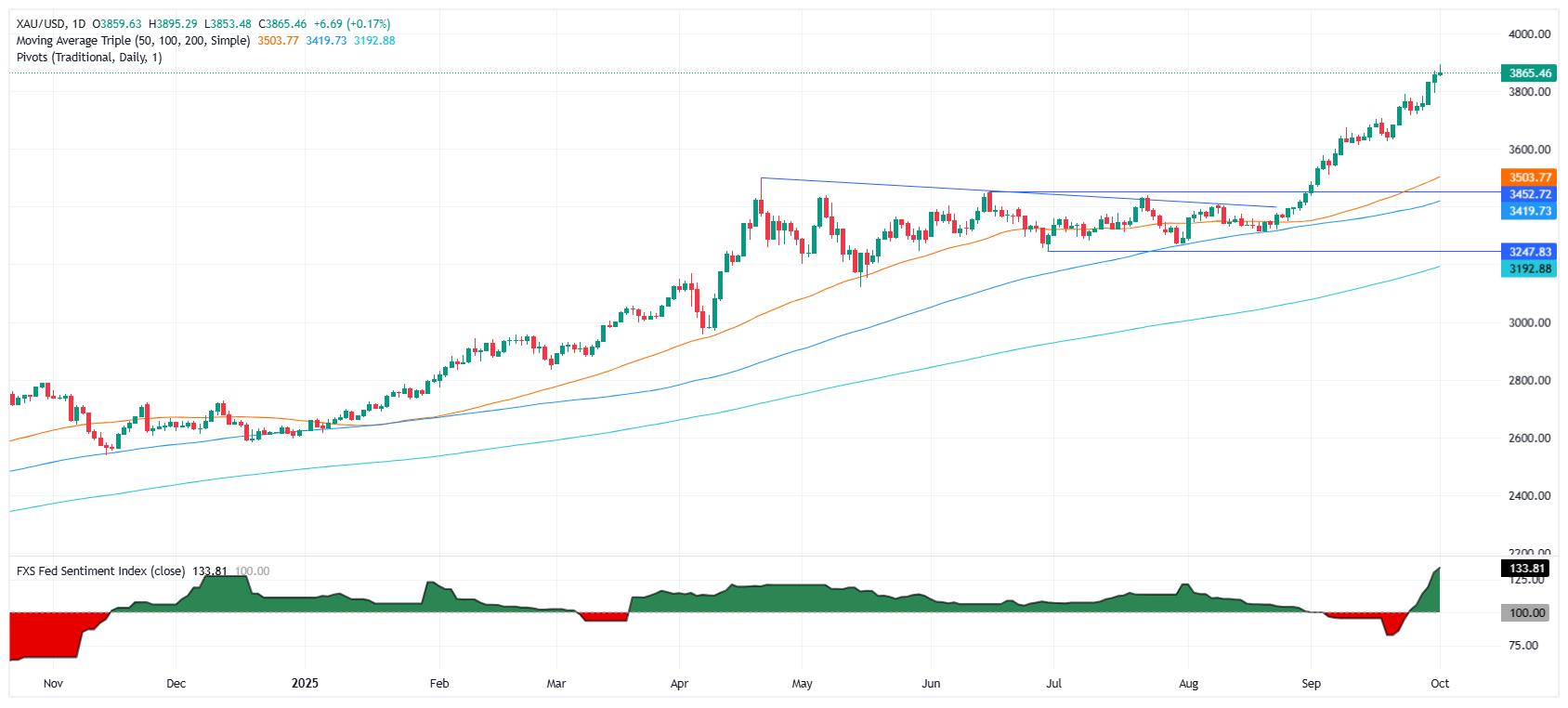Gold smashes record $3,895 as Fed cut bets intensify
- ADP report shows that private hiring in September plunged, reinforcing bets for a Fed rate cut later this month.
- US government shutdown delays Nonfarm Payrolls release, weighs on markets but support flows into Gold.
- Treasury yields tumble and US Dollar softens, creating a favorable backdrop for bullion’s rally toward fresh record highs.
Gold price surges on Wednesday and posts a record high of $3,895, yet it has since retreated somewhat, trading with gains of over 0.30%. The shutdown of the US government and softer-than-expected employment data reaffirmed investors' stance that the Federal Reserve (Fed) would reduce interest rates at its upcoming meeting.
XAU/USD trades at $3,871 at the time of writing, propelled by falling US Treasury yields and a firm US Dollar.
Bullion holds near $3,871 as weak jobs data and US government shutdown fears boost safe-haven demand
Financial markets remain in a positive mood, despite the shutdown of the US government, which could delay the release of the Friday Nonfarm Payrolls report. Jobs data revealed earlier showed that private hiring plunged in September, according to the ADP National Employment Change report.
Other data showed that manufacturing activity recovered in September, but remained in contractionary territory, as revealed by the Institute for Supply Management (ISM).
In the meantime, the Greenback post modest losses of over 0.11%, a tailwind for Bullion prices.
Expectations that the Federal Reserve would reduce rates at the October 29 meeting remain high, standing at 98% for a 25-basis-point rate cut and a 4% chance of holding rates unchanged.
Daily market movers: Gold price climbs on soft US jobs data
- Bullion prices advance as the Greenback edges down, as shown by the US Dollar Index (DXY). DXY, which tracks the buck’s value against a basket of six currencies, is down 0.11% at 97.68.
- US Treasury yields plunge as the 10-year Treasury note tanks nearly five basis points to 4.106%. US real yields—calculated by subtracting inflation expectations from the nominal yield—, which correlate inversely to Gold prices, are also unchanged at 1.796%.
- ADP revealed that private payrolls shrank by -32,000 in September, following August’s downward revision of -3,000 jobs. Forecasts suggested that companies would add at least 50,000 new employees to their workforce.
- The ISM Manufacturing PMI increased to 49.1 in September from 48.7 in August, though it was the seventh month that the PMI was in contractionary territory, though above estimates of 49.
- Job openings in the US showed the labor market is slowing, yet vacancies rose from 7.21 million to 7.23 million in August. Digging into the data, the hiring rate edged down to 3.2%, the lowest level since June 2024, while layoffs remained at a low level.
Technical outlook: Gold price poised to challenge $3,900
Gold price is upward biased, despite the formation of a ‘shooting star’ candle, with bearish implications. Nevertheless, fundamentals and risk sentiment favor further upside, though a fall below the September 30 low of $3,793 could sponsor a test of the 20-day Simple Moving Average (SMA) at $3,698.
On the flipside, XAU/USD could challenge the current all-time high at $3,895, ahead of breaching $3,900.

Gold FAQs
Gold has played a key role in human’s history as it has been widely used as a store of value and medium of exchange. Currently, apart from its shine and usage for jewelry, the precious metal is widely seen as a safe-haven asset, meaning that it is considered a good investment during turbulent times. Gold is also widely seen as a hedge against inflation and against depreciating currencies as it doesn’t rely on any specific issuer or government.
Central banks are the biggest Gold holders. In their aim to support their currencies in turbulent times, central banks tend to diversify their reserves and buy Gold to improve the perceived strength of the economy and the currency. High Gold reserves can be a source of trust for a country’s solvency. Central banks added 1,136 tonnes of Gold worth around $70 billion to their reserves in 2022, according to data from the World Gold Council. This is the highest yearly purchase since records began. Central banks from emerging economies such as China, India and Turkey are quickly increasing their Gold reserves.
Gold has an inverse correlation with the US Dollar and US Treasuries, which are both major reserve and safe-haven assets. When the Dollar depreciates, Gold tends to rise, enabling investors and central banks to diversify their assets in turbulent times. Gold is also inversely correlated with risk assets. A rally in the stock market tends to weaken Gold price, while sell-offs in riskier markets tend to favor the precious metal.
The price can move due to a wide range of factors. Geopolitical instability or fears of a deep recession can quickly make Gold price escalate due to its safe-haven status. As a yield-less asset, Gold tends to rise with lower interest rates, while higher cost of money usually weighs down on the yellow metal. Still, most moves depend on how the US Dollar (USD) behaves as the asset is priced in dollars (XAU/USD). A strong Dollar tends to keep the price of Gold controlled, whereas a weaker Dollar is likely to push Gold prices up.

